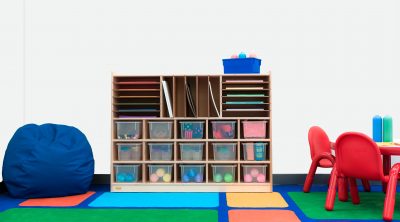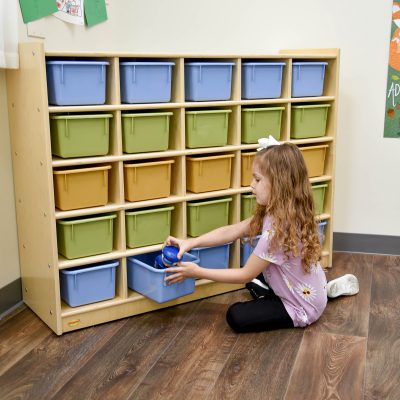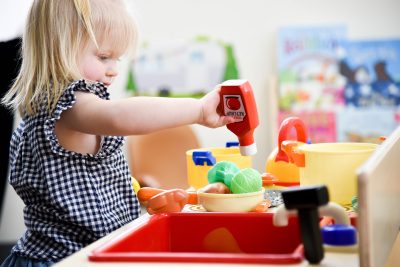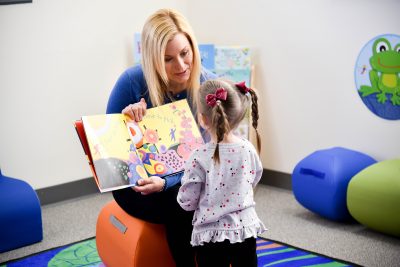
Why Can’t They Just Behave? A Guide to Understanding Early Childhood
GUEST POST: By Laurie Prusso, Earlychildhood News
Parents truly are their children’s first and best teachers. When it comes to dealing with children’s behavior, sometimes the job seems bigger than we would like it to be. Every day our children can behave in ways that frustrate, embarrass, and confound us. Some of the behaviors they display are just related to being a child. Other behaviors, however, are related to our habits and responses to them.

Teach kids how to declutter spaces with storage solutions. Pictured here: Mobile Sectioned Storage with Clear Trays.
Some parents are really confused about what kind of behavior is cute, what is normal, and what is inappropriate. Parents may spend a lot of time explaining, bargaining, and convincing their child to understand why to behave, in the end missing an opportunity to teach the desired actions. Some parents, even if they want to do something about misbehavior, don’t know what to do, or are reluctant to anger or disappoint a child. Parents need to recognize what, when, and how to teach children the skills they want them to have. Children can learn to behave and it is our responsibility to teach them these skills.
Think Ahead
How do you want your child to behave when he is 10, 14, or even 18? Those behaviors need to be taught now, when your child is young. When my children were growing up, it was important to me that they speak politely at the dining table. In fact, it was important that they came to the dining table! Even if they chose not to eat, which they could, we all sat down together at mealtime. As adults, I wanted them to have the skills to be appropriate and comfortable in many environments. Some of these skills were, asking politely, thanking appropriately, speaking graciously, and helping to serve and clean. It would have been silly of me to expect this behavior without implementing some teaching strategies and supportive relationships to accomplish them. These are basic manners, which all children need to develop in order to be successful in the world outside of their family environment. It is not very helpful to allow children too much flexibility at home and then expect good behavior when they are away from home.
Other desired behaviors may include things like getting homework done and turned in on time, taking care of things, and being responsible for something else. These things won’t just happen. We can have an expectation and then have a big gap between the expectation and the child’s ability to live up to it. Sometimes that gap is the missing teaching and learning that needs to occur. Fortunately, there are some effective ways to teach and support your child’s learning about behavior.
It might be fun for you to create a list of the characteristics you would like your child to have when he is ready to move away to attend college. Make a long list first, and then try to narrow it down to 10 or 12 of the most important qualities. You can begin to teach and provide practice for those attributes and characteristics now when your child is young.
The Four E’s of Parenting – Example, Education (Explicit and Implicit), Experience, & Encouragement
The Four E’s of parenting provide a concrete way for you to think about helping your child accomplish desired learning and appropriate behavior. You are the key player. Instead of just wishing your child would behave, you are responsible for the teaching, training, and follow-through.

We offer many colorful bins and trays to help organize everything in your child’s playroom or homeschool. Pictured here: Bins in almond, sky, and fern.
The Four E’s sometimes overlap, but that is fitting, as this provides reinforcement and fortification for your child’s learning. For example, you will soon see that when you respond kindly and patiently to a child’s ridiculous request for banana splits for dinner, you are setting a good example and providing encouragement. You may also be teaching something about nutrition and appropriate limit setting. Or, if you decide that banana splits represent at least 3 of the food groups, you are demonstrating how to be flexible, fun, and collaborative. Life is like that. It matters more how you do something, than what you do.
Example:
Of course, example is the most powerful teacher in the world. Your influence on your child is almost immeasurable. You have the ability to set the tone for the day, to listen patiently, to be compassionate, and to organize your home in loving and fun ways. This influence belongs to you! If you use it wisely, you will make the greatest impact possible on your child.
Check yourself to see if the example you are setting is the one you want to set. Do you behave in ways that you want your child to behave? Do you speak to your child and to others the way you want to hear your child speak? If you want your child to be kind and patient, are you kind and patient? Do you complain? Procrastinate? Swear? Yell? If you do, it is likely that your child will too. When you speak to and about your spouse, are you respectful, loving, and kind? Your child will learn how to talk to you and to others by the way you speak to and about others. Your child will absorb your mannerisms and habits like a sponge and there is nothing you can do to stop it. Be the kind of person you want your child to become. Example is the most powerful tool you have.
Education:
We can intentionally and consciously teach children things we want them to know. We can teach them skills for living, manners for getting along, and we can teach them ways to make decisions. The two kinds of education that we typically use are explicit and implicit. Explicit teaching occurs when we think in advance about something that we want to teach our child, and then set up a learning experience, such as baking a cake. Implicit teaching occurs when we read children’s literature and talk informally about things in life. Implicit teaching also occurs as our children watch our every move and internalize what we teach with our lives.
Experience:
In order to become skilled at anything, we need opportunities to experience the process and practice the skill. Growing up is a time for practicing and gaining experience in life. Children have not yet mastered all of the behaviors and skills that we sometimes expect from them. When misbehavior occurs, we may look at it as an opportunity to provide more practice (experience), education, and support for the desired learning. Remember when you learned to type? If the teacher punished you when you made mistakes, and then took the typewriter away because you still made mistakes the third or fourth time you typed, you would never have learned to be successful in that skill!
Encouragement:
Incourage {sic}. Put courage in! Your child, like all children, will do better when he feels good about himself and his relationship with you, not in a sappy, permissive way, but in a caring and supportive way. We can encourage our children to try, try again, keep trying, and find different ways to try. Relationships are the greatest motivation for appropriate behavior. Focusing on the child and the relationship is often a better way to improve behavior than is focusing on the behavior itself. Think about something you love to do and have become good at. Either you struggled alone, which wasn’t very fun and made it a lot harder, or you had some encouragement from others. Children will be more successful if they are full of courage!
Putting It Into Practice:
You can put the Four E’s into practice for any skill or behavior that you want your child to develop. Remember the steps: example, education, experience, and encouragement. First consider what it is you want your child to learn. Look at yourself as an example. Does your behavior need some tweaking and finishing before you expect better of your child? Be honest and willing to grow. Criticism is really a discouragement strategy whether we use it on our children or on ourselves. Just decide what you want to do better, and start doing.

Pretend play kitchens allow toddlers to watch, learn and then put those principles into action! Pictured here: Toddler 2-In-1 Kitchen – ANG1092.
Now consider some ways that you can really teach the idea or skill to your child. Is there a game you could play? Is it something done everyday in your home, and you just need to allow your child to get involved with some pointers and some practice? Dusting is one such skill. Other household chores are also easily taught in a fun and cooperative way.
Think about how and when your child will practice this new knowledge and turn it into learning. We haven’t really learned something until we use it! Get ready to encourage, support, laugh, and guide. Keeping our long-term goals in mind will help us relax and enjoy the process.
How to Make a Bed, and Other Important Life Skills
Let’s try a simple skill from start to enjoyment as an introduction to this new method. Let’s say I want to teach my child to make his bed each day. He is three years old, so my expectation of the way the bed might look will be influenced by this and will be appropriately adjusted. But, I keep in mind that what I really want is a 10-year-old who has mastered this skill and habit. And more than that, I want my children to grow up and take care of themselves. My long-term goals will keep me going. That is what parenting is about.
Example:
Do I make my bed daily? If not, I will start. I will involve my child in making my bed with me, taking special care to fluff the pillows, throw them around, and have a bunch of fun. If I leave home for work too early each day, I will make beds with my child every Saturday and Sunday (or whatever mornings I am home). We will move from my bed to his bed and repeat the fun.
Education:
I will read stories about children who participate in things that create something meaningful. Miss Tizzy is a great example. I will read stories about those who don’t! The Little Red Hen comes to mind. Then we can have a discussion about cooperation and helping in our family. Over time, I will teach my child the skill of bed making. Tightening the sheets and smoothing them out, laying the blanket over the sheet, and covering with the spread or comforter will be some of the steps. Fluffing the pillow will always be a fun time.

Read to kids to make sure they understand the importance of this skill.
Experience:
For now, I will be at my child’s side, or he at mine, when making a bed. Later, he will try it alone. It might not look perfect or even good, but that won’t matter, because I have six or seven years to support his practice. Maturity and physical skill will help with this. And my standards of what his bed should look like might change over time.
Encouragement:
My relationship with this little one will grow as we have fun together in my bedroom and then in his. I will help and support, without criticism, as he learns how to do this desired, but not crucial housekeeping task. Remember, it’s not about the bed.
Conclusion
This model for teaching can be adapted and used for anything you want your child to learn. If things aren’t working out, perhaps another teaching method in the education step will help, or, perhaps they need more practice. Remember, telling is not teaching! Teaching requires opportunities for new knowledge, practice, and mastery.
When it comes to behavior, our children are counting on us to know what to do. If we want them to be kind, when they pick up a block to throw at another child, we tell them firmly and clearly to put it down, and we follow through by walking toward them to remove the block. Then if desired, use the Four E’s to teach about kindness, impulse control, feelings, and more! What a wonderful way to show your child that you love him and to help him be successful in the world.